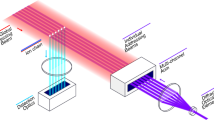Abstract
This paper first considers sequential quantum machines (SQMs). The SQMs thatpossess an isometric transition operator and the SQMs that are factorizable orstrongly factorizable are characterized. Quantum Turing machines (QTMs) arestudied next and an alternative proof of the result that characterizes the unitaryevolution of a QTM is given. It is shown that any QTM can be represented interms of two quantum printers which are much simpler than a QTM. UnidirectionalQTMs are studied and it is shown that their corresponding quantum printers areclosely related to each other. A simple method for constructing unidirectionalQTMs is given. Finally, a preliminary development of generalized QTMs andquantum pushdown automata is presented.
Similar content being viewed by others
REFERENCES
E. Bernstein and U. Vazirani (1997), SIAM J. Comput. 26, 1411–1473.
S. Gudder (1999), Int. J. Theor. Phys. 38, 2259–2280.
S. Gudder (1988), Quantum Probability (Academic Press, New York).
C. Moore and J. Crutchfield, Theor. Comp. Sci. (to appear).
A. Paz (1971), Introduction to Probabilistic Automata (Academic Press, New York).
Author information
Authors and Affiliations
Rights and permissions
About this article
Cite this article
Gudder, S. Quantum Computers. International Journal of Theoretical Physics 39, 2151–2177 (2000). https://doi.org/10.1023/A:1003692611402
Issue Date:
DOI: https://doi.org/10.1023/A:1003692611402




